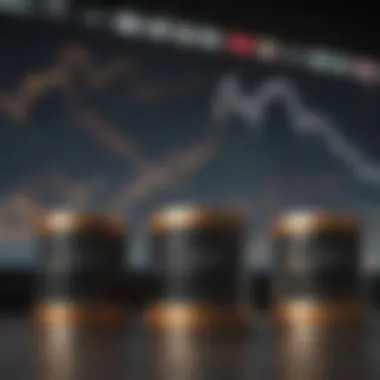Insights Into Today's Oil and Gas Market Dynamics


Intro
The oil and gas market is a constantly shifting landscape, influenced by myriad factors ranging from global demand fluctuations to local geopolitical events. For those contemplating investment in this sector, understanding the elements at play becomes paramount. This guide aims to shed light on these complexities, offering valuable insights for both the seasoned investor and those just starting out.
In the coming sections, we will dissect key concepts, strategies, and the broader dynamics shaping this market today. With the backdrop of rising energy concerns and the ongoing transitions toward sustainable alternatives, knowing where to look and how to navigate can prove beneficial.
Investment Dictionary
Definition of Key Terms
To effectively analyze the oil and gas sector, familiarity with certain terminology is essential. Here are a few terms that will be pivotal in your journey:
- Brent Crude: A major trading classification of crude oil originating from the North Sea. It is a benchmark for oil pricing in the global market.
- WTI (West Texas Intermediate): Another oil benchmark, often representing lighter crude oil found primarily in the U.S.
- E&P (Exploration and Production): The segment of the oil and gas industry responsible for locating and extracting oil and gas from the earth.
Commonly Used Financial Concepts
Grasping financial concepts related to oil and gas investments can significantly sharpen your analytical capabilities:
- Netback: The profitability of a barrel of oil or gas after subtracting transportation, production, and other costs.
- Operating Margin: A measure of a company’s operational efficiency in the oil and gas market — calculated as revenue minus operating expenses.
- Capex and Opex: Capital expenditures (long-term investments) versus operating expenditures (day-to-day costs) — crucial for evaluating the financial health of energy firms.
Expert Advice
Investment Strategies
Navigating investment in the oil and gas market requires calculated strategic approaches. Here are some techniques:
- Diversification: Spread investments across various companies within the sector to mitigate risks associated with price volatility.
- Focus on Fundamentals: Examine financial statements, production capacities, and reserve levels to assess long-term potential rather than relying solely on market trends.
- Monitor Geopolitical Events: Oil prices can swing based on political stability in oil-rich regions, so keeping an eye on news developments is a wise strategy.
Risk Management Techniques
In the volatile world of oil and gas, risk management will be your best friend:
- Stop-Loss Orders: Set these to limit potential losses on investments, especially given the unpredictable nature of oil prices.
- Hedging: Use financial instruments to offset potential losses, particularly around periods of expected turbulence in the market.
- Continuous Education: Stay informed about market trends, technological advancements, and regulatory changes that may affect investments in the oil and gas sector.
Investing in oil and gas is not just about understanding the numbers; it's also about grasping the larger picture, including geopolitical developments and their impacts on the market.
As we continue, delving deeper into pricing trends and the technology reshaping the industry can further enhance your strategic positioning in this complex arena.
Overview of the Oil and Gas Market
Understanding the oil and gas market today is crucial for informed decision-making, especially for investors keeping a keen eye on global economic shifts. This sector is more than just a commodity market; it plays a foundational role in shaping economies, influencing geopolitical relations, and propelling technological advancements. A thorough grasp of the market's structure and the historical context establishes a solid groundwork for analyzing current conditions and forecasting future trends.
Historical Context
The roots of the oil and gas market can be traced back to the mid-19th century when coal was primarily the dominant energy source. As time passed, the advent of the internal combustion engine brought crude oil to the forefront. The establishment of Standard Oil and the OPEC alliance in the 20th century shifted the dynamics of global energy significantly.
Years of fluctuating prices, driven by wars, oil embargoes, and significant geopolitical events, have shaped the landscape we see today. The oil shocks of the 1970s served as a wake-up call, highlighting the vulnerability of reliance on foreign oil. More recently, the shale revolution in the U.S. fundamentally changed the supply-demand dynamics, prompting a rethinking of energy independence on a national level.
This historical backdrop underscores that understanding the industry is not just tracing the price changes but also grasping the political, social, and technological evolutions that influence them.
Market Structure
The oil and gas market consists of various players, ranging from multinational corporations like BP and Chevron, to smaller independent exploration and production companies. The market structure can be categorized by:
- Upstream: This segment is focused on exploration and production. It includes activities related to locating oil and gas fields and extracting these resources.
- Midstream: Comprising transportation and storage, this sector ensures that oil and gas are moved from extraction sites to refineries.
- Downstream: This part of the market involves refining crude oil into usable products like gasoline, diesel, and petrochemicals, along with distribution.
Understanding where a company fits into this matrix is paramount for investors, as it directly affects their exposure to fluctuations in raw material prices and regulatory changes.
Current Market Conditions
At present, the oil and gas market finds itself in a delicate dance influenced by numerous factors. Global demand is shifting with a notable increase in electric vehicle adoption and tightening regulations on emissions. Meanwhile, supply chain disruptions and geopolitical tensions, particularly involving major producers, pose both risks and opportunities.
Prices have been on a rollercoaster ride. The recent spike can be attributed to rising demand post-pandemic, coupled with challenges in production ramp-up. It’s crucial to recognize how these elements intertwine: as prices rise, so does the incentive for exploration, but higher costs can discourage usage, creating a complex web of market dynamics.


"In the oil and gas sector, every increase in demand can lead to unpredictability, and investors must tread carefully amidst the chaos."
This volatility exemplifies the need for constant vigilance and adaptability in investment strategies. Investors are advised to consider the interplay of these conditions, as they can transform seemingly stable environments into tumultuous waters, affecting everything from stock valuations to market entries and exits.
Price Trends and Forecasts
The oil and gas market stands as a pivotal element in the global economy, influencing everything from manufacturing costs to energy pricing for consumers. Understanding Price Trends and Forecasts becomes essential not just for industry insiders, but also for those with financial stakes in this robust sector. Price fluctuations can directly impact investment decisions and corporate strategies; hence, being informed on this subject can yield significant benefits. Whether one is newly stepping into investing or is a veteran, engaging with these insights equips stakeholders to make informed choices.
Global Price Fluctuations
Oil prices are notoriously volatile. A myriad of elements, such as geopolitical tensions or unexpected changes in supply, can send prices ballooning or plummeting overnight. For instance, when unrest brews in oil-rich regions, such as the Middle East or Venezuela, traders tend to speculate about potential supply disruptions, pushing prices higher.
Several key factors contribute to these global fluctuations:
- Supply and Demand Mechanics: A surplus of oil typically leads to lower prices, while higher demand amidst limited supply results in price surges.
- Economic Indicators: National economic health can influence oil consumption. Countries experiencing growth often consume more energy.
- Technological Changes: Advances in fracking and drilling technology can lead to increased supply, impacting the market's balance.
Understanding these fluctuations isn’t just for analysts; it also helps investors identify optimal buying or selling periods, providing a competitive edge.
Factors Influencing Oil Prices
Price predictions are primarily influenced by layers of factors that intertwine with the global economy. Here are some prominent influences:
- OPEC Actions: The Organization of the Petroleum Exporting Countries plays a crucial role in regulating oil supply to maintain stable prices. Any decision made during OPEC meetings can ripple through the market.
- Geopolitical Events: Political instability in oil-producing nations can lead to sudden price hikes.
- Currency Fluctuations: Since oil is traded in U.S. dollars, changes in the strength of the dollar can influence prices. A weaker dollar makes oil cheaper for buyers holding other currencies, potentially driving up demand.
These evolving conditions create a landscape where investors need to keep a vigilant eye on news and reports, correlating these influences to potential price movements.
Gas Pricing Dynamics
Shift your focus to natural gas, it's a different yet equally complex ballgame. Natural gas prices tend to be less volatile than oil but are still influenced by several parameters:
- Regional Supply Gluts: Certain regions, like the U.S., may have significant reserves that can keep prices in check. For instance, the shale boom led to an oversupply of natural gas.
- Seasonal Demand Variations: Gas prices commonly rise during winter months, driven by increased heating needs.
- Domestic vs. International Markets: In some cases, domestic gas prices can diverge significantly from international prices, influenced by local regulations and infrastructure constraints.
In light of these dynamics, investors should focus on understanding how changes in both local and global markets affect pricing trends. This foundational comprehension can guide not only investment choices but also operational strategies for companies involved in exploration and production.
"In an industry as interconnected and unpredictable as oil and gas, staying updated on pricing trends is non-negotiable for anyone seeking to navigate successfully."
Diving deep into these facets of pricing allows for a more cohesive understanding of the oil and gas market, preparing stakeholders to not only weather storms but also thrive within this ever-evolving landscape.
Geopolitical Influences
OPEC's Role in the Market
The Organization of the Petroleum Exporting Countries (OPEC) stands at the helm of global oil production, wielding significant influence over pricing and supply. Established in 1960, OPEC’s collective strategy can make or break oil prices worldwide. For instance, when member nations decide to cut production, prices may rise due to scarcity—even a modest adjustment can create a surge in market reaction. Similarly, when OPEC decides to increase production, it can flood the market and lead to lower prices, impacting revenues for producers globally.
Contributions of OPEC are not only measured in barrels but also in their diplomatic interactions. Their annual meetings are pivotal, often leading to shifts in policies that can affect global markets. The balance of power in OPEC, influenced by countries like Saudi Arabia and Iraq, continuously shapes the strategic decisions made within the organization. This is particularly essential for investors to keep an eye on, as any decision made by OPEC can dramatically influence an investor's portfolio.
"OPEC’s ability to modify supply highlights the precarious balance between political will and economic stability in the energy sector."
Regional Conflicts Impacting Supply
The oil and gas market is intricately tied to regional conflicts, making the navigation of this landscape complex. Conflicts such as those in the Middle East, North Africa, and even in parts of Latin America disrupt supply chains regularly. For example, the ongoing strife in Libya has historically led to fluctuations in production levels and has created uncertainty in global markets.
Additionally, tensions between major oil-producing nations can spark fears of supply interruption, causing prices to rise. An example is the U.S.-Iran tensions, which have often led to market jitters about the Strait of Hormuz, a vital shipping passage for oil. Investor sentiment can shift rapidly based on headlines, and the volatility underscores the importance of being informed about geopolitical tensions affecting oil supply.
To navigate these influences, it is essential for investors to:
- Stay updated on current events through reliable news sources.
- Understand the geopolitical landscape of oil-producing regions.
- Monitor changes in government policies and relations between nations.
US Energy Policies
U.S. energy policies play a crucial role in the global oil and gas market. With policies that can shift rapidly due to changes in administration, the impact can be substantial. For instance, the promotion of domestic production through deregulations during certain administrations led to a surge in shale oil production, significantly impacting global oil prices.
Moreover, policies regarding sanctions on countries like Venezuela and Iran influence supply chains and pricing. When the U.S. imposes sanctions, these nations struggle to sell their oil internationally, which can tighten the market and drive prices upwards. The interplay of domestic and international policies creates a complex backdrop that investors must navigate.


In summary, keeping an eye on U.S. energy policies and understanding their implications is vital for anyone involved in the oil and gas market.
With the continuing evolution of political landscapes worldwide, stakeholders must remain vigilant. Any shifts—be it from OPEC's decisions, regional conflicts, or U.S. policy changes—can drastically alter market conditions in the blink of an eye.
Technological Advancements
The oil and gas industry is amidst a transformative phase, driven primarily by technological advancements. These innovations are no longer a mere add-on—they're becoming the backbone of the sector, affecting every link in the value chain. Investors and stakeholders must recognize that embracing technology is essential for enhancing efficiency, reducing costs, and maintaining competitive edge.
Exploration and Production Technologies
The exploration phase hinges on the ability to pinpoint reserves with precision. New techniques, such as 3D oilfield modeling, leverage seismic imaging to provide more accurate assessments of subsurface geology. Instead of relying solely on traditional drilling methods, many companies now turn to data analytics. The use of machine learning algorithms allows geologists to analyze vast amounts of data, identifying new extraction spots more efficiently than before. As a result, this not only reduces drilling risks but also lowers operational costs significantly.
In an era where resources are dwindling and the costs are sky-high, technologies such as hydraulic fracturing and horizontal drilling have redefined production capabilities. These methods unlock previously inaccessible reserves. Furthermore, integrating IoT devices within drilling operations enables real-time monitoring, ensuring safety and optimizing production rates simultaneously. The blend of these technological advancements can boost production output while keeping eco-friendly initiatives in mind.
Refining Process Innovations
The refining sector has also seen substantial innovations that cater to efficiency and sustainability. Petrochemical processing has benefited from cutting-edge techniques like catalytic cracking, which increases yields of valuable products while reducing by-products. This isn’t just about processing crude oil anymore; it’s about extracting every possible benefit from each drop.
Moreover, digital refineries harness data analytics to optimize operations in real-time. By tracking performance metrics, refineries can ensure that processes remain in peak condition. This level of monitoring facilitates quick adjustments to maintain optimal output, ultimately boosting profitability. Additionally, investments in carbon capture technologies showcase a commitment to sustainability, minimizing the carbon footprint associated with refining processes. This is not only about complying with environmental regulations but also about capturing the interests of modern consumers who prioritize sustainability in their investment decisions.
Impact of Renewable Energy Technologies
As the global energy landscape evolves, the intersection of oil and gas with renewable energy technologies becomes increasingly relevant. The oil and gas sector is not wholly at odds with renewables; in fact, many companies are diversifying their portfolios to include solar and wind developments. Moreover, technological merge is evident in ventures deploying hybrid systems that utilize both fossil fuels and renewables.
The push for renewable tech isn't just an empty net; companies investing in this domain stand to gain a competitive advantage in an industry that's pivoting towards a more sustainable future. Innovations like battery storage and smart grid management can potentially transform how the oil and gas sector approaches energy distribution.
"Adapting and adopting new technologies can mark the difference between merely surviving and thriving in a continually changing market."
In summary, technological advancements in exploration, refining, and renewable energy are not just trends; they're vital components shaping the future of the oil and gas industry. Investors must stay alert to these developments, as they directly influence not just market dynamics but also long-term sustainability within this critical sector.
Investment Landscapes
In the context of the oil and gas market, Investment Landscapes play a crucial role in shaping the strategies of investors. This section explores the various dimensions of investment in this sector, encompassing the potential benefits that can be gained, alongside significant considerations that demand attention. In an environment characterized by volatility and rapid change, understanding these investment landscapes can make or break an investment strategy.
Market Opportunities
The current oil and gas market presents numerous avenues for investment. One must keep an eye on both traditional and emerging segments. For instance, as the push for cleaner energy sources gains momentum, companies pivoting towards sustainable methods within fossil fuel extraction or investing in carbon capture technologies are increasingly appealing to investors.
- Increasing Demand: As economies emerge from pandemic-induced slumps, demand for energy is escalating. This recovery phase provides a ripe opportunity for investments, particularly in exploration and production sectors.
- Technological Innovations: Advances in drilling technology, such as horizontal drilling and hydraulic fracturing, are game changers. They not only boost production efficiency but also lower operational costs.
- Mergers and Acquisitions: The market is witnessing a wave of consolidation. For savvy investors, identifying companies that may likely merge can unearth opportunities yielding substantial returns.
These factors create a dynamic landscape where investors can strategically position themselves based on market signals and data.
Risk Factors to Consider
While the potential rewards in the oil and gas investment landscape are alluring, it’s essential to navigate with caution. Various risk factors can potentially derail investment strategies, including:
- Market Volatility: Prices for oil and gas can swing wildly due to geopolitical tensions or sudden shifts in supply and demand. Investors must brace for unexpected downturns.
- Regulatory Challenges: The oil and gas industry is under the watchful eye of governments, which may impose stricter regulations related to environmental concerns. Compliance costs can also cut into profits.
- Technological Disruption: The rise of renewable energy is more than just a trend. It's a looming shift that could redefine the energy landscape, posing a risk to investments geared solely toward fossil fuels.
Thus, a comprehensive risk assessment is imperative before diving into the investment pool.
Long-term vs Short-term Investment Strategies
Choosing between long-term and short-term investment strategies in the oil and gas sector requires a thoughtful approach. Here’s how to consider each:
- Short-term Strategies: This approach focuses on making quick gains, often leveraging market fluctuations. Day trading, for instance, becomes an avenue for those who feel confident in their ability to read market signs.
- Long-term Strategies: Taking a longer view generally involves buying shares in stable, growth-oriented oil and gas companies, ideally leading to cumulative gains over time. This may also include investments in dividend-yielding stocks, providing regular income streams.
- Benefits: Instantly realize profits and quickly adapt to market changes.
- Challenges: Requires constant vigilance and can lead to emotional decision-making.
- Benefits: Less frequent trading means lower transaction fees, and investing in established companies can lead to greater stability.
- Challenges: Investors risk losing capital if the industry struggles in the long run.
Environmental Considerations
The oil and gas market operates under increasingly scrutinized environmental standards. The intersection of this sector with global climate change initiatives has made understanding its environmental considerations paramount. These considerations not only shape regulatory frameworks but also influence investor sentiment, market adaptability, and corporate sustainability practices.


Regulatory Framework
Policymakers are often juggling economic interests and environmental concerns. Various regulations aim to minimize ecological impact while ensuring energy security. For instance, major regulations such as the Clean Air Act and the Clean Water Act in the United States mandate strict emissions limits and set standards for water discharges from facilities. This lightweight governance pushes companies to adopt cleaner technology or suffer hefty fines.
A critical component in the regulatory framework is the role of international agreements. The Paris Agreement highlights a global commitment towards reducing greenhouse gas emissions. Companies involved in oil and gas operations must navigate these waters carefully, aligning their business strategies not only to meet local regulations but also to contribute to global targets.
Corporate Sustainability Practices
There's an undeniable shift in how corporations approach sustainability. Businesses in the oil and gas sector are increasingly aware that their reputation hangs on their environmental stewardship. Efforts such as developing practices for carbon capture and storage or investing in renewable energy projects are gaining traction in boardrooms.
For example, companies like BP and Shell have initiated projects aimed at reducing carbon footprints. These practices can reduce operational costs in the long run and foster goodwill among consumers and investors alike, who increasingly prefer companies that prioritize environmental health. Furthermore, sustainable practices can lead to Enhanced Oil Recovery (EOR) techniques which not only promote efficient resource use but also mitigate environmental harm.
Market Responses to Climate Change Concerns
Market reactions to climate change issues are rapid and multifaceted. Investors are becoming increasingly informed and selective about where they place their funds. Many are shifting their focus toward companies with robust environmental policies. For instance, as awareness grows, a fund that invests heavily in fossil fuels may plummet while one emphasizing renewable energy sources gains popularity.
"In today's investing climate, you can no longer afford to ignore environmental factors; they are as critical as financial performance."
Public pressure is motivating energy companies to respond proactively. Some firms are now producing annual sustainability reports to outline their strategies for advancement and compliance with environmental standards. On the other hand, not responding to climate change concerns can have severe consequences. Companies that neglect these vital issues risk backlash from the public and investors, leading to diminished market share and eroding trust.
Understanding and integrating these environmental considerations isn’t just a regulatory necessity; it’s becoming a hallmark of strategic business operation in the oil and gas landscape.
Future Outlook
Understanding the future outlook of the oil and gas market is crucial for investors, policymakers, and stakeholders alike. As the dynamics of the industry shift due to multiple factors including technological advancements and changing consumer behavior, the ability to predict trends becomes invaluable. Investors need to be on their toes, ready to adapt strategies based on emerging patterns and insights. This section will explore three critical elements shaping the future of the oil and gas market: predictions for the next decade, shifts in global energy demand, and the emphasis on clean energy transition.
Predictions for the Next Decade
Looking ahead, the next ten years in the oil and gas sector are likely to be defined by volatility and unpredictability. Experts suggest that we might see a gradual transition towards a more diversified energy portfolio. Some anticipating a steady decline in fossil fuel demand, while others project peaks and troughs influenced by geopolitical tensions and regulatory frameworks across the globe.
- Increased Pricing Pressure: Corporations will need to brace for fluctuating prices due to global supply chain disruptions and policies aimed at reducing carbon emissions.
- Investment in Technology: With the advent of AI and blockchain, the industry could witness significant investments in technology aimed at enhancing efficiencies.
- Market Segmentation: We can also expect a segmentation in markets based on their energy consumption needs and reliance on renewables.
It's a balancing act for investors. Riding the wave of technological advancements while being cautious of market volatility becomes key to making informed decisions.
Shifts in Global Energy Demand
As we navigate the complexities of the energy landscape, shifts in global demand will undoubtedly impact the oil and gas market. Factors contributing to these shifts include population growth, urbanization, and evolving energy policies aimed at promoting cleaner alternatives.
- Emerging Economies: Countries like India and parts of Southeast Asia are slated to increase energy consumption drastically, potentially fueling demand for oil and gas resources.
- Developed Markets: Conversely, developed markets might see a decrease in oil consumption as they increasingly favor alternative energies and implement more stringent emissions regulations.
- Technological Changes: The advent of electric vehicles and advancements in renewable energy technologies could create a paradigm shift, steering some traditional oil consumers toward greener options.
This balancing act between growing demand from emerging markets and declining reliance in developed areas makes predictions challenging yet vital for stakeholders.
Emphasis on Clean Energy Transition
The push for cleaner energy solutions is more pronounced now than ever before. With climate initiatives taking center stage, oil and gas companies must pivot towards sustainability to maintain relevance in a rapidly changing market.
- Corporate Responsibility: Companies are integrating sustainability into their core strategies, which could mean significant changes in operations and product offerings.
- Investment in R&D: The focus on renewable energy sources is prompting companies to invest heavily in of research and development, looking for innovative partnerships to tackle climate change.
- Policy Influence: Government regulations will markedly influence how businesses approach energy production, making compliance and proactive adaptation critical.
"To stay ahead, companies can no longer view sustainability as an optional add-on. It's becoming core to the business strategy."
As the world pivots towards a greener future, the transition phase presents both challenges and opportunities. Investors who recognize this shift can position themselves strategically to benefit from new avenues while mitigating risks associated with traditional market volatility.
Closure
In the ever-shifting landscape of the oil and gas market, understanding the factors that govern this industry has never been more vital. The conclusion of this article synthesizes the insights gleaned from various sections, drawing from the complexities discussed. First and foremost, it underlines that knowledge is power, especially in a sector so heavily influenced by global trends, geopolitical tensions, and advancements in technology. By analyzing the evolution of market conditions and price dynamics, investors can make informed decisions tailored to their risk tolerance and financial goals.
Summary of Insights
The intricate dance between supply and demand in oil and gas markets reveals nuances not often captured in surface-level reports. The analysis emphasized several pivotal insights:
- Historical Trends: An understanding of historical price fluctuations aids in predicting future movements. Global events—economic crises, conflicts, or breakthrough technologies—play a decisive role.
- Investment Considerations: Investors should consider both short-term opportunities and long-term strategies, recognizing that volatility is par for the course in this industry.
- Environmental Awareness: Growing regulatory pressures related to climate change can either pose risks or offer new avenues for innovation. Engaging with corporate sustainability practices can influence investments positively.
"Investing in oil and gas is like navigating a ship through stormy seas; knowing when to set the sails and when to drop anchor is crucial to weathering the waves."
Encouragement for Proactive Engagement
Proactive engagement in the oil and gas market is paramount for both seasoned investors and newcomers alike. The industry is not just about reacting to price drops or spikes but also about anticipating shifts in energy demand and adjusting strategies accordingly. Investors should:
- Stay Informed: Regularly follow news outlets, reports from organizations like OPEC, and insights from financial analysts to stay ahead of the curve.
- Network: Engaging with other market participants can yield invaluable insights. Forums, conferences, and online communities can provide a deeper understanding of sentiments and expectations.
- Adapt: As renewable energy technologies evolve, the oil and gas sectors must adapt. Investors who remain flexible and open to change will find themselves in a stronger position.
In essence, approaching the oil and gas market with both caution and curiosity allows for better investment outcomes. Knowledge and adaptability are not just beneficial; they're essential in navigating this multifaceted landscape.



